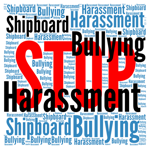 Eliminating harassment and bullying on board ships 21.04.2024 02:37
Eliminating harassment and bullying on board ships 21.04.2024 02:37Harassment and bullying on board ships can have serious consequences for the physical and emotional health of seafarers, lead to decreased motivation and increased sickness and can compromise cohesive and effective teamwork. It can also have negative effects for companies, resulting in a deterioration of working conditions and potential organisational, economic and legal consequences.
Harassment is a form of discrimination which has the purpose or effect of violating the dignity of a person and of creating an intimidating, hostile, degrading, humiliating or offensive environment.
Bullying is a form of harassment that includes hostile or vindictive behaviour, which can cause the recipient to feel threatened or intimidated. It results in a work environment in which a group of people or an individual may become threatened or intimidated because of the negative or hostile behaviour of another group of people or individual. Bullying may involve a misuse of power or position and is often persistent and unpredictable. It may be vindictive, cruel or malicious. However it can also arise when a person is unaware of the effect that their behaviour is having on other persons, or does not have any intention to bully.
The following may be found to be examples of harassment:
• Displaying or circulating offensive or suggestive material;
• Innuendo, mockery, lewd or sexist/racist/homophobic jokes or remarks;
• Use of offensive language in describing or making fun of someone with a disability;
• Comments about a person’s physical appearance or character which cause embarrassment or distress;
• Unwelcome attention such as spying, stalking, pestering, overly familiar behaviour or unwelcome
verbal or physical attention;
• Making or sending unwanted, sexually suggestive, hostile or personally intrusive telephone calls, text messages, emails, comments on social networks, faxes or letters;
• Unwarranted, intrusive or persistent questioning about a person’s age, marital status, personal life, sexual interests or orientation, or similar questions about a person’s racial or ethnic origin, including their culture or religion;
• Unwelcome sexual advances or repeated requests for dates or threats;
• Suggestions that sexual favours may further a person’s career, or that not offering them may adversely affect their career;
• Leering, rude gestures, touching, grabbing, patting or other unnecessary bodily contact such as brushing up against others; and
• Spreading malicious rumours, or insulting someone (particularly regarding age, race, marriage, civil partnership, pregnancy and maternity, sex, disability, sexual orientation, religion or belief, and gender reassignment).
The following may be found to be examples of bullying:
• Verbal or physical threats or abuse, such as shouting or swearing at colleagues, either in public or in private, including derogatory or stereotyped statements or remarks;
• Personal insults;
• Belittling or ridiculing a person, or his/her abilities, either in private or in front of others;
• Sudden rages or displays of temper against an individual or group, often for trivial reasons;
• Subjecting someone to unnecessary excessive or oppressive supervision, monitoring everything they do or being excessively critical of minor things;
• Persistent or unjustified criticism;
• Making unreasonable demands of staff or colleagues;
• Setting menial or demeaning tasks that are inappropriate to the job or taking away areas of responsibility from an individual for no justifiable reason;
• Ignoring or excluding an individual from social events, team meetings, discussions and collective decisions or planning;
• Making threats or inappropriate comments about career prospects, job security or performance appraisal reports; and
• Spreading malicious rumours, or insulting someone (particularly regarding age, race, marriage, civil partnership, pregnancy and maternity, sex, disability, sexual orientation, religion or belief, and gender reassignment).
• Shunning people at work and rebuffing their efforts to integrate with others if they are believed to ‘not fit in’;
• Cyber bullying including inappropriate:
– Suggestive and unwanted remarks;
– Graphics or threat-centred, abusive emails;
– Postings on social networks; and
– Text messages.
• There are sometimes situations when excuses are made to, define or refer to behaviour or situations between people at work which may involve ‘hidden’ bullying:
– Strong or robust management styles;
– A working relationship that is described as a ‘personality clash’;
– Someone being described as ‘over-sensitive’ or ‘unable to take a joke’;
– Describing someone as having an ‘attitude problem’;
– A manager who ‘has a low tolerance for non-safety critical mistakes which are made unintentionally; and
– Making fun of someone who has made a minor mistake at work.

Companies should ensure that they have a clearly written Policy Statement on the elimination of harassment and bullying. An example of such a Policy can be found below:
Company x will treat all complaints of harassment and bullying seriously and in strict confidence.
Your senior officer on board and personnel manager ashore have been trained in dealing with complaints of harassment and bullying. You may approach either or both to report any incident you have suffered.
The company considers any complaint of cyber bullying to be a serious issue.
If you do not feel comfortable raising a complaint yourself, you may ask a friend or colleague to do so on your behalf. You will not be penalised by the company for making a complaint, provided it is not vexatious or made maliciously.
Remember, it is the victim’s perception of any actions that counts. If YOU feel you have suffered harassment or bullying, the company will look into the issue raised.
Company Name:
Contacts:

Our company offers you services for the development of internal regulatory documents in accordance with the requirements of the Maritime Labour Convention (MLC, 2006).
